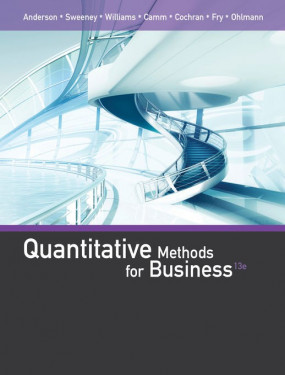Gain a strong understanding of the role of management science in the decision-making process while mastering the latest advantages of Microsoft® Office Excel® 365 with Camm/Cochran/Fry/Ohlmann/Anderson/Sweeney/Williams' AN INTRODUCTION TO MANAGEMENT SCIENCE: QUANTITATIVE APPROACHES TO DECISION MAKING, 16E. This market-leading edition uses a proven problem-scenario approach as the authors introduce each quantitative technique within an application setting. You learn to apply the management science model to generate solutions and make recommendations for management. Updates clarify concept explanations while new vignettes and problems demonstrate concepts at work. All data sets, applications and screen visuals reflect the details of Excel® 365 to prepare you to work with the latest spreadsheet tools.
- A hallmark strength of this text, the authors' unique problem-scenario approach introduces problems using the management science model and introduces each quantitative technique within an application setting. Students must apply the management science technique to each problem to generate a business solution or recommendation.
- Each chapter includes a list of learning objectives that reflects Bloom's taxonomy. Every end-of-chapter problem now includes a descriptive problem title and lists the learning objectives that correspond to the problem for convenient review.
- Known for its practical, real-world emphasis, this book provides actual, timely data drawn from real business. Theses meaningful examples emphasize application as well as solid management science and quantitative methodology.
- Six new "Management Science in Action" vignettes describe how material covered in this edition is actually used in practice today. In addition, more than 15 end-of-chapter problems are new and many are updated.
- Expanded discussions clarify key concepts.
Cengage Digital App includes Data Files
1. Introduction
2. An Introduction to Linear Programming
3. Linear Programming: Sensitivity Analysis and Interpretation of Solution
4. Linear Programming Applications in Marketing, Finance, and Operations Management
5. Advanced Linear Programming Applications
6. Distribution and Network Models
7. Integer Linear Programming
8. Nonlinear Optimization Models
9. Project Scheduling: PERT/CPM
10. Inventory Models
11. Waiting Line Models
12. Simulation
13. Decision Analysis
14. Multicriteria Decisions
15. Time Series Analysis and Forecasting
16. Markov Processes
Appendix A: Building Spreadsheet Models
Appendix B: Areas for the Standard Normal Distribution
Appendix C: Values of e–λ
Appendix D: References and Bibliography
Appendix E: Answers to Even-Numbered Problems
Jeffrey D. Camm
Jeffrey D. Camm is the Inmar Presidential Chair and senior associate dean of business analytics programs in the School of Business at Wake Forest University.
James J. Cochran
James J. Cochran is associate dean for research, a professor of applied statistics and the Rogers-Spivey Faculty Fellow at The University of Alabama.
Michael J. Fry
Michael J. Fry is a professor of operations, business analytics and information systems as well as academic director of the Center for Business Analytics in the Carl H. Lindner College of Business at the University of Cincinnati.
Jeffrey W. Ohlmann
Jeffrey W. Ohlmann is associate professor of business analytics and a Huneke Research Fellow in the Tippie College of Business at the University of Iowa.
David R. Anderson
David R. Anderson is a leading author and professor emeritus of quantitative analysis in the College of Business Administration at the University of Cincinnati.
Dennis J. Sweeney
Dennis J. Sweeney is professor emeritus of quantitative analysis and founder of the Center for Productivity Improvement at the University of Cincinnati.
Thomas A. Williams













